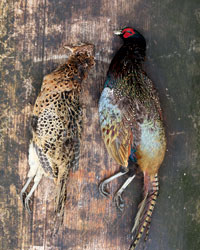Recipe: pheasant with celery, cream and pimentón


Roula Khalaf, Editor of the FT, selects her favourite stories in this weekly newsletter.
The pheasant is the poor relation in the game family. It is the least expensive and most plentiful of game birds. It does not have quite the same majesty as a grouse or a woodcock in terms of taste. But it is beautiful to look at and requires a bit of effort by the cook.
If you have a brace of tender young hens and they have been hung in a cool place for a week, pheasants can be simply roasted. They will need barding with fat bacon and must be cooked so that the legs are no longer pink but the breasts are not dry. Served with bread sauce, a good gravy, some game chips and a few chipolatas, they are a treat – but skill and good timing are required.
It is the dread tendency for the breasts to dry out – and the legs to be tough and scrawny – that necessitates careful treatment. The salmis route is a good one, whereby the birds are briefly roasted for 15 minutes, then jointed, and a sauce made with the carcass in which the legs are braised and the breasts warmed through briefly.
I have evolved a third method consisting of practically poaching the birds in cream – excess can be avoided if the birds are wedged into a tight-fitting pot. Combined with some fiery pimentón, it produces a piquant but unctuous result.
Rowley Leigh is the chef at Le Café Anglais
——————————————-
Pheasant with celery, cream and pimentón
Ingredients
The celery is a good foil to both pheasant and sauce: peeled and seeded cucumber, cut in small sections, briefly sautéed and added to the sauce at the end, is a good alternative. Serves four.
2 plump pheasants
25g butter

2 heads celery
2 shallots
2 cloves of garlic
1 tsp pimentón picante
1 tsp pimentón dulce
1 small glass dry vermouth or dry white wine
150ml double cream
● Season the trussed pheasants well with salt and pepper. Heat an ovenproof casserole just large enough to hold the birds and melt half the butter. Add the pheasants and turn down the heat so that the butter gently foams without burning. Leave the pheasants on their sides so that they colour really well before turning on their other side and repeating the process, and then finishing on the back of the birds. The whole process should take 10 minutes. Remove the birds and discard the butter. Do not clean the casserole.
● While the pheasant is browning, trim the base of the celery, remove the coarse outer stalks and the tops, leaving about 16cm of the heart. Split these in half and then in half again. Drop them into boiling salted water for one minute only. Drain and refresh them in cold water.
● Peel and chop the shallots and garlic very finely. Melt the last teaspoon of butter in the casserole and briefly colour the blanched celery hearts in it. Lift them out and then add the garlic and shallots. Sweat them gently so that they become transparent. Add both types of pimentón and stir it in well, scraping up the juices from the dish as you go. After a moment or two, add the vermouth or wine and finish off the deglazing, or collecting all the juices that have caramelised on the base of the casserole. Do not let the wine reduce too much. Pour in the double cream and bring it briefly to the boil before returning the pheasants to the dish. Fit the celery quarters around the birds. Cover with a lid or a piece of foil and place in a medium-hot oven (gas mark 6) for 15 minutes.
● Remove the casserole from the oven and leave to stand, still covered, for 10 minutes. Lift out the pheasants on to a chopping board. Lift out the celery hearts on to a plate. Once cool enough to handle, carefully remove the legs, taking care to get the “oyster” under the backbone at the top corner of each leg. Slice down either side of the breast bone and remove the breasts, together with the wings. The breasts should be just cooked through, and the underside of the thighs still slightly bloody. Put the casserole back on the heat. If the creamy sauce is runny, bring it back to the boil and reduce over a medium to high heat (it should not bubble up uncontrollably) for a few moments until it thickens. Add the legs and poach them in the sauce for two minutes, just enough to allow the meat to cook through. Add the breasts and celery and gently heat through. Do not let the meat boil in the sauce or cook too long, as it will toughen quickly. The sauce may need a pinch of salt and a squeeze of lemon to sharpen it up. Serve with rice pilaf.
Comments